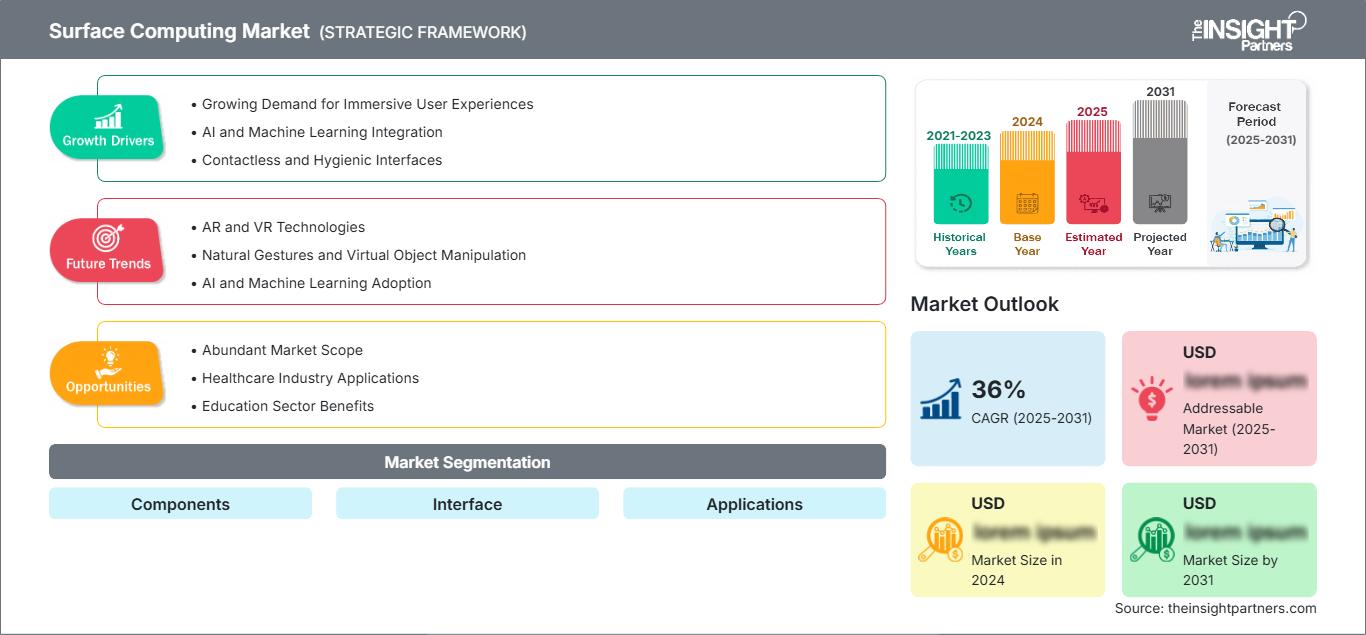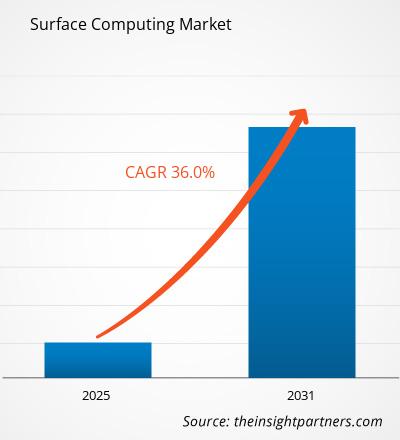Le marché du Surface Computing devrait atteindre 2 012,55 milliards de dollars américains d'ici 2031. Il devrait enregistrer un TCAC de 30,3 % entre 2025 et 2031.
L'étude de marché sur le Surface Computing est segmentée en différents sous-segments. Elle propose également une analyse basée sur les types d'interfaces et les applications, notamment dans les secteurs académique et corporatif. L'analyse globale est ventilée par région et par principaux pays. L'évaluation du marché est exprimée en dollars américains pour l'analyse segmentaire ci-dessus.
Objectif du rapport
Le rapport « Marché du Surface Computing » de The Insight Partners vise à décrire le paysage actuel et la croissance future, les principaux facteurs de croissance, les défis et les opportunités. Cela permettra d'éclairer divers acteurs économiques, tels que :
- Fournisseurs de technologies/Fabricants : Pour comprendre l'évolution de la dynamique du marché et identifier les opportunités de croissance potentielles, afin de prendre des décisions stratégiques éclairées.
- Investisseurs : Pour réaliser une analyse approfondie des tendances concernant le taux de croissance du marché, les projections financières et les opportunités tout au long de la chaîne de valeur.
- Organismes de réglementation : Pour encadrer les politiques et les activités du marché afin de minimiser les abus, préserver la confiance des investisseurs et garantir l'intégrité et la stabilité du marché.
Composantes de la segmentation du marché du Surface Computing
Interface
Applications
Géographie
- Amérique du Nord
- Europe
- Asie-Pacifique
- Amérique du Sud et centrale
- Moyen-Orient et Afrique
Vous bénéficierez d’une personnalisation sur n’importe quel rapport - gratuitement - y compris des parties de ce rapport, ou une analyse au niveau du pays, un pack de données Excel, ainsi que de profiter d’offres exceptionnelles et de réductions pour les start-ups et les universités
Marché de l'informatique de surface: Perspectives stratégiques

- Obtenez les principales tendances clés du marché de ce rapport.Cet échantillon GRATUIT comprendra une analyse de données, allant des tendances du marché aux estimations et prévisions.
Facteurs de croissance du marché du Surface Computing
- Demande croissante d'expériences utilisateur immersives : Le besoin croissant de moyens intuitifs et attrayants d'interagir avec le contenu numérique stimule la demande en Surface Computing.
- Intégration de l'IA et de l'apprentissage automatique : Les progrès des technologies d'IA et d'apprentissage automatique améliorent les systèmes de Surface Computing, permettant des interactions intelligentes et personnalisées.
- Interfaces sans contact et hygiéniques : L'importance des interfaces sans contact, devenues essentielles après la pandémie de COVID-19, s'inscrit pleinement dans la croissance du Surface Computing.
- Progrès technologiques et réduction des coûts : Les améliorations technologiques continues et la baisse des coûts accélèrent la croissance du marché du Surface Computing.
Tendances futures du marché du Surface Computing
- Technologies de RA et de RV : La réalité augmentée (RA) et la réalité virtuelle (RV) continueront d'améliorer le Surface Computing, offrant des expériences utilisateur immersives et interactives.
- Gestes naturels et manipulation d'objets virtuels : L'informatique de surface permettra aux utilisateurs de manipuler des objets virtuels par des gestes naturels, fusionnant ainsi les mondes physique et numérique de manière innovante.
- Adoption de l'IA et de l'apprentissage automatique : Une meilleure intégration de l'IA et de l'apprentissage automatique rendra l'informatique de surface plus intuitive et personnalisée grâce à une meilleure compréhension des intentions de l'utilisateur.
- Solutions respectueuses de l'environnement : Une sensibilisation accrue favorisera le développement d'écrans basse consommation et de technologies de récupération d'énergie pour une informatique de surface plus durable.
Opportunités du marché de l'informatique de surface
- Vaste potentiel de marché : Le marché de l'informatique de surface offre de vastes opportunités aux entreprises et aux innovateurs, avec l'émergence de nouvelles applications dans divers secteurs.
- Applications dans le secteur de la santé : L'informatique de surface peut améliorer la formation médicale, les interventions chirurgicales et les soins aux patients grâce à des technologies interactives et immersives.
- Avantages pour le secteur de l'éducation : Dans le domaine de l'éducation, l'informatique de surface favorise la créativité et les expériences d'apprentissage interactives, stimulant ainsi l'engagement des élèves.
- Innovation dans le secteur du commerce de détail : l’informatique de surface permet des recommandations de produits personnalisées et améliore l’interaction des clients avec les présentoirs de produits en magasin.
Marché du Surface Computing
Les analystes de The Insight Partners ont analysé en détail les tendances régionales et les facteurs influençant le marché du Surface Computing tout au long de la période prévisionnelle. Cette section aborde également les segments et la répartition géographique du marché de la gestion des troubles du rythme cardiaque en Amérique du Nord, en Europe, en Asie-Pacifique, au Moyen-Orient et en Afrique, ainsi qu'en Amérique du Sud et centrale.
Portée du rapport sur le marché du Surface Computing
| Attribut de rapport | Détails |
|---|---|
| Taille du marché en 2024 | US$ XX Billion |
| Taille du marché par 2031 | US$ 2012.55 Billion |
| TCAC mondial (2025 - 2031) | 30.3% |
| Données historiques | 2021-2023 |
| Période de prévision | 2025-2031 |
| Segments couverts |
By Composants
|
| Régions et pays couverts | Amérique du Nord
|
| Leaders du marché et profils d'entreprises clés |
|
Densité des acteurs du marché du Surface Computing : comprendre son impact sur la dynamique commerciale
Le marché du Surface Computing connaît une croissance rapide, portée par une demande croissante des utilisateurs finaux, elle-même alimentée par l'évolution des préférences des consommateurs, les progrès technologiques et une meilleure connaissance des avantages du produit. Face à cette demande grandissante, les entreprises élargissent leur offre, innovent pour répondre aux besoins des consommateurs et tirent parti des tendances émergentes, ce qui stimule davantage la croissance du marché.

- Obtenez le Marché de l'informatique de surface Aperçu des principaux acteurs clés
Points clés de vente
- Couverture exhaustive : Ce rapport analyse en détail les produits, services, types et utilisateurs finaux du marché du calcul de surface, offrant ainsi une vision globale.
- Analyse d'experts : Ce rapport repose sur une connaissance approfondie du secteur et des analystes.
- Informations actualisées : Grâce à sa couverture des informations et tendances les plus récentes, ce rapport garantit la pertinence de vos analyses.
- Options de personnalisation : Ce rapport peut être personnalisé pour répondre aux besoins spécifiques de chaque client et s'adapter parfaitement à ses stratégies commerciales.
Ce rapport d'étude de marché sur le calcul de surface peut donc vous aider à décrypter et comprendre le contexte sectoriel et les perspectives de croissance. Malgré quelques points à améliorer, les avantages de ce rapport l'emportent généralement sur les inconvénients.
- Analyse historique (2 ans), année de base, prévision (7 ans) avec TCAC
- Analyse PEST et SWOT
- Taille du marché Valeur / Volume - Mondial, Régional, Pays
- Industrie et paysage concurrentiel
- Ensemble de données Excel
Rapports récents
Témoignages
Raison d'acheter
- Prise de décision éclairée
- Compréhension de la dynamique du marché
- Analyse concurrentielle
- Connaissances clients
- Prévisions de marché
- Atténuation des risques
- Planification stratégique
- Justification des investissements
- Identification des marchés émergents
- Amélioration des stratégies marketing
- Amélioration de l'efficacité opérationnelle
- Alignement sur les tendances réglementaires




















 Obtenez un échantillon gratuit pour - Marché de l'informatique de surface
Obtenez un échantillon gratuit pour - Marché de l'informatique de surface